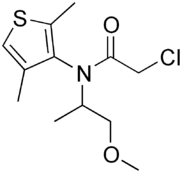Dimethenamid
Dimethenamid is a widely used herbicide. In 2001, about 7 million pounds of dimethenamid were used in the United States.[3] Dimethenamid is registered for control of annual grasses, certain annual broadleaf weeds and sedges in field corn, seed corn, popcorn and soybeans. Supplemental labeling also allows use on sweet corn, grain sorghum, dry beans and peanuts. In registering dimethinamide (SAN 582H/Frontier), EPA concluded that the primary means of dissipation of dimethenamid applied to the soil surface is photolysis, whereas below the surface loss was due largely to microbial metabolism. The herbicide was found to undergo anaerobic microbial degradation under denitrifying, iron-reducing, sulfate-reducing, or methanogenic conditions.[4] In that study, more than half of the herbicide carbon (based on 14C-labeling) added was found to be incorporated irreversibly into soil-bound residue.
 | |
| Names | |
|---|---|
| IUPAC name
(RS)-2-Chloro-N-(2,4-dimethyl-3-thienyl)-N-(2-methoxy-1-methylethyl)acetamide | |
| Other names
Frontier Herbicide Dimethenamid-P ((S)-isomer) | |
| Identifiers | |
3D model (JSmol) |
|
| ChEBI | |
| ChemSpider | |
| ECHA InfoCard | 100.121.887 |
| KEGG | |
PubChem CID |
|
| RTECS number |
|
| UNII | |
CompTox Dashboard (EPA) |
|
| |
| |
| Properties | |
| C12H18ClNO2S | |
| Molar mass | 275.79 g/mol |
| Appearance | Tan to brown liquid |
| Density | 1.141 g/cm3 |
| Hazards | |
| Main hazards | Xn (harmful) |
| Safety data sheet | MSDS from BASF |
| R-phrases (outdated) | R22 |
| Flash point | 151 °C (304 °F; 424 K) |
Except where otherwise noted, data are given for materials in their standard state (at 25 °C [77 °F], 100 kPa). | |
| Infobox references | |
References
- Dimethenamid at Sigma-Aldrich
- Material Safety Data Sheet from BASF
- 2000-2001 Pesticide Market Estimates Archived 2009-02-07 at the Wayback Machine, U.S. Environmental Protection Agency
- Crawford, J.J.; Sims, G. K.; Simmons, F. W.; Wax, L. M.; Freedman, D. L. (2002). "Dissipation of the herbicide (14C) Dimethenamid under anaerobic aquatic conditions in flooded soil microcosms". J. Agric. Food Chem. 50 (6): 61483–1491. doi:10.1021/jf010612i. PMID 11879025.